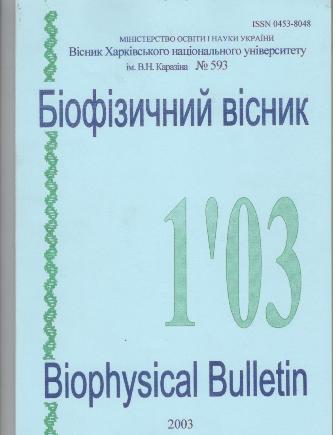Моделирование процессов связывания актиноциновых антибиотиков с ДНК при разных ионных силах и температурах
Анотація
Методом спектрофотометрического титрования исследованы комплексы актиноцинового антибиотика ActII с ДНК. Были рассмотрены две модели с одними и двумя местами связывания лигандов, описываеммые уравнениями МакГи и фон Хиппела с разными значениями параметров. Для выбора оптимальной модели комплексообразования была использована программа оптимизации спектрофотометрических концентрационных зависимостей DALSMOD. С помощью этой программы установлено, что в системе ActII – ДНК присутствуют, по крайней мере, три по-разному поглощающих комплекса. Логарифмы констант комплексообразования на каждом из мест связывания лигандов с матрицей ДНК линейно зависят от логарифма концентрации NaCl. Анализ спектров поглощения рассмотренных смесей ActII – ДНК при разных температурах позволил оценить величины H и для каждого типа комплексов. Полученные значения энтропии положительны в растворах 2×10-2 М NaCl и отрицательны при 0,15 М NaCl.
Завантаження
Посилання
Graves DE, Velea LM. Intercalative binding of small molecules to nucleic acids. 2002;27.
Experts from the annual research report for 1997 auckland cancer society research centre. Drug development programme.
Karapetian AT. J.Biomol.Struct.Dyn. 1990;8(1):123-30.
Peyrratout C, Donath E, Daehne L. J. Photochem. Photobiol. 2001;142:51-7.
Nyrgen J, Svanvik N, Kubista M. Biopolymers. 1998;46:39-51.
Tuite E, Norden B. J. Am. Chem. Soc. 1994;116:7548-56.
Antonov L, Gergov G, Petrov V, Kubista M, Nnygren J. Talanta. 1999;49:99-106.
Manning CS. Biopolymers. 1979;18:2357-8.
Glibin EN, Ovchinnikov DV, Plekhanova NG. ZhOr.Kh. 33(10):1573-6. (in Russian)
Veselkov AN, Davies DB. Anticancer Drug Desing. SEVNTU PRESS; 2002.
Kruglova EB. Biofizicheskii vestnik. 2002;1(10):12-20. (in Russian)
Kruglova EB. Biofizicheskii vestnik. 2001;1(8):27-41. (in Russian)
Nechipurenko IuD. Molekuliarnaia biologiia. 1984;18:1066-80. (in Russian)
McGhee JD, von Hippel PH. J.Mol.Biol. 1974;86:469-89.
Hartley F, Burgess C, Alcock R. Solution equlibra. Ellis Horwood, 1980. 360p.
Shchelkina AK. Molekuliarnaia biologiia. 1977;11(2):466-71. (in Russian)
Semenov MA. Biofizicheskii vestnik. 2001;2(9):40-4. (in Russian)
Marky LA, Blumenfeld KS, Breslauer KJ. Nucleic Acids Research. 1983;11(9):2857-70.
Sauer BB, Flint RA, Justice JB, Trowbridge CG. Arch. Biochem. Biophys. 1984;234(2):580-4.
Kubota Y, Eguchi Y, Hashimoto K, Wakita M, Honda Y, Fujisaki Y. Bull. Chem. Soc. Japan. 1976;49(9):2424-6.
Автори, які публікуються у цьому журналі, погоджуються з наступними умовами:
- Автори залишають за собою право на авторство своєї роботи та передають журналу право першої публікації цієї роботи на умовах ліцензії Creative Commons Attribution License, котра дозволяє іншим особам вільно розповсюджувати опубліковану роботу з обов'язковим посиланням на авторів оригінальної роботи та першу публікацію роботи у цьому журналі.
- Автори мають право укладати самостійні додаткові угоди щодо неексклюзивного розповсюдження роботи у тому вигляді, в якому вона була опублікована цим журналом (наприклад, розміщувати роботу в електронному сховищі установи або публікувати у складі монографії), за умови збереження посилання на першу публікацію роботи у цьому журналі.
- Політика журналу дозволяє і заохочує розміщення авторами в мережі Інтернет (наприклад, у сховищах установ або на особистих веб-сайтах) рукопису роботи, як до подання цього рукопису до редакції, так і під час його редакційного опрацювання, оскільки це сприяє виникненню продуктивної наукової дискусії та позитивно позначається на оперативності та динаміці цитування опублікованої роботи (див. The Effect of Open Access).





